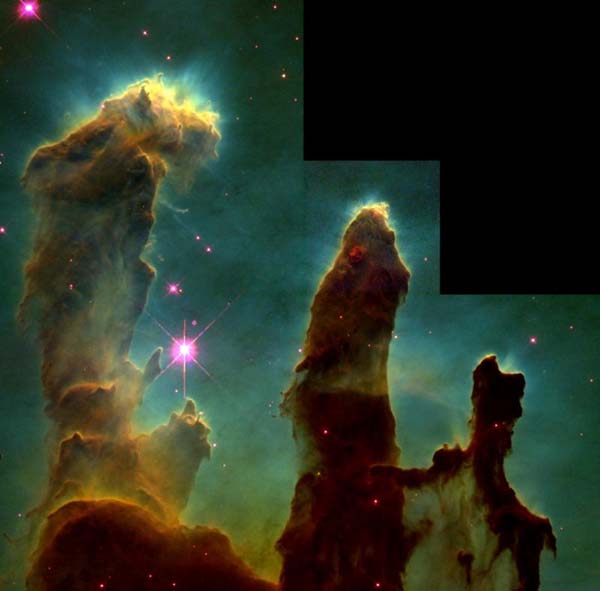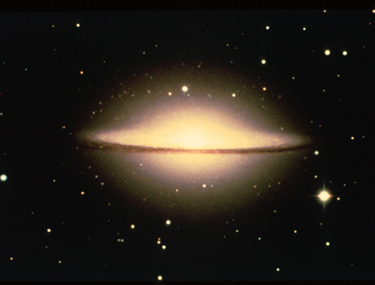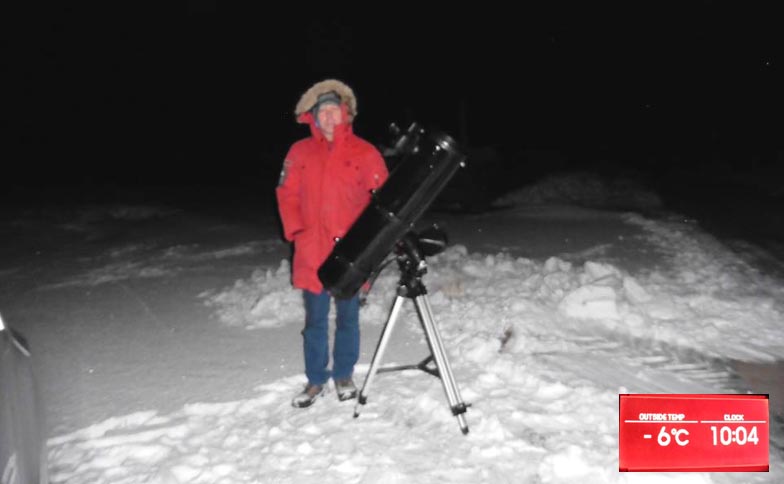 |
Members
Notes (1) |
 |
Members
Notes (1) |
 |
This
has to be one of the most awe inspiring images ever taken by the Hubble space
telescope it is of M 16 the famous Pillars of Creation located within the Eagle
nebula in the constellation of Serpen. These massive gas clouds light years high
are the very birthplace of countless stars some of which can be seen burning bright
through the dark dust clouds and frozen hydrogen from which they were created. If you look closer at the middle finger towards the top you can make out one of the stellar eggs( stellar Nebula ) from which the stars are born drawn in by the relentless pull of gravity over millions of years the gas clouds slowly condense downwards the enormous pressure forcing the frozen Hydrogen atoms ever closer and as the temperature soars to a staggering 10 million degree's Centigrade Nuclear fusion takes place lighting up the star Submitted by Peter Struve |
| Viewing Log 1 February 2012 at Uffcott by Pete Chappell | |
|
NGC 2362 (also known as Caldwell 64) is an open cluster in the constellation Canis Major. |
|
|
Michael Partridge
from Swindon Stargazers had arranged for a viewing session at Uffcott.
This meant I would miss an evening of playing Bridge, as I also play
on Thursday night I think I could miss one night for the week? I had
been out the previous Monday in cold weather and tonight it was going
to be colder and with a stronger wind. |
|
| Viewing Log 14 January 2012 at Uffcott by Pete Chappell | |
|
This was going to be the first viewing session of 2012. I had planned this session about five days before hand, sent out e mails to all the regulars and hoped we would have clear skies? I got replies from Michael Partridge, Robin and Hilary Wilkey (all from Swindon Stargazers) and Peter Eslick and Jon Gale (both from Wiltshire AS) saying they could make the session. Arranged a time for 19:30 onwards and would meet at Uffcott as usual, this place was going to be first time for Michael, Robin and Hilary. I was the first to arrive at 19:25 and was met with a wonderful clear but cold (minus one according to the car) sky, could be in for a good one tonight was my thought? I have a new plan
for this year, my project is to view most (if not all) of the Herschel
400 Observing Guide by Steve O’Meara’s. This will require
me to do a viewing plan before I go out, something I do not normally
do, at all! So during the afternoon I went through the book and picked
out my targets for the night. The book is split in to monthly targets
and over a course of about seven nights, you should see all of the targets
Steve O’Meara has chosen. After reading and writing down the targets,
I chose four nights and 17 objects to view, I packed up the car and
went off to Uffcott. For this session I would be using my trusted eight inch Meade LX90 and various Pentax XW eye pieces. While setting up the telescope, Michael was the first to arrive and said WOW! The sky is really clear here, had to agree with him! After doing my set ups, I went off to Jupiter as Michael said he could only find two moons using a 15x70 binoculars. I had to agree with him, two of the moons were not on view, this was a first for me. |
NGC 2022 is a planetary nebula in the constellation Orion |
|
Turned out, Ganymede was in front of Jupiter and Europa was behind the planet as viewed from planet Earth. Hopefully come back to Jupiter later on and see what the moons were doing? I left Michael to his own items to view while I started on the Herschel list. January and first night with four items to view: New General Catalogue (NGC) 1647, an Open Cluster (OC) in Taurus was the first object to view, this OC is 3.5 degrees north east of Aldebaran and was a pretty good object to view. In fact most of this short list was going to be OC’s. NGC 1817 and 1664 were the next targets, these were okay to view. I had trouble in finding 1664, as my list said 1644 and the hand controller said it was not up yet? Does help to get the correct numbers! By now Hilary and Robin had turned up and their comments were very similar to Michael’s, WOW and a few other good words. I was now in Auriga and looking at NGC 2126, a dim OC which most people would probably not look at? Next was NGC 1857, again in Auriga and an OC, again this was a dim OC. NGC 1907 got a good report from me, this OC is much tighter than the rest I had seen tonight and had brighter stars at magnitude (Mag) 8.2. The first Emission and Reflection Nebula of the night was NGC 1931, this looked similar to M42 but much fainter, but still good to look at! The last two, Jon and Peter turned up within 20 seconds of each other, so the lay-by was full and hopefully our night vision would not be affected by car head lights? Jon had brought his trusted Vixen on a mini Porter Mount while Peter was going to set up his LX90 and take some pictures of Jupiter. My last object in Auriga was NGC 2281, a good looking OC with some bright stars within it.
Peter Chappell |
| Viewing Log 25th March, 2017 at Uffcott by Rob Slack |
 M51 - The Whirlpool Galaxy in Ursa Major |
| After
weeks of rotten weather, at least for astronomers, we finally had a clear
night forecast on a weekend and no Moon either - it was simply too good
a night to pass up. So I packed scope and all into back of the car and
drove out to Uffcott, just to the southwest of Swindon, last Saturday
the 25th March. Upon arrival, it was dark, at least looking to the south, clear but a little windy at times, not ideal, but still worth a punt! Once I had set up my Helios Newtonian with a two inch eyepiece, FL of 32mm and allowed it to settle for half an hour I set about locating a few targets I had in mind from the Sky Briefs. Normally at home in the suburbs of Swindon, I would struggle to to find these targets, due to the light pollution. So I started by using the star Alkaid in Ursa Major, to last star in the milk pan handle. Using this as a starting point I first scanned around to the right of this star to locate the Whirlpool galaxy, M51 and it's partner NGC5195. Moving further to the right I next encountered M63 the Sunflower galaxy before shooting right past Alkaid to find the very fuzzy blob of the Pinwheel, M101. Then I set about locating two old friends, galaxies I used to observe quite a bit when I lived on a farm, to the north of Bath - M65 and M66, both edge on galaxies in Leo, on the lions thigh I guess. These are great targets and although books claim they are magnitude 9, they look brighter than that, maybe because they are edge on. Staying with the two inch eyepiece and now an OIII filter I had a look at M42 in Orion, before Orion sets till next winter. A fabulous sight, no matter how many times I observe it and the OIII filter really brings it alive! Final target of the night was Jupiter. Again cannot quite get on Jupiter at home, it is too low. But From Uffcott, it looked great, even though the wind did a good job of rocking the scope. To all out there with fancy GOTO scopes, you might consider my little challenge rather easy peasy! But I have no such tech and have to star hop! Apart from M42 and Jupiter, none of the objects are visible even in my three inch finderscope, so I had to literally sweep the general area where I knew these objects were, makes all the more rewarding when you do finally nail them in the centre of the eyepiece. Soon after that I packed it in, as I had forgotten my gloves and hands were flipping cold. As the clocks have now gone forward and the evenings get lighter now, I was glad I pushed myself off the settee and away from the Voice UK and got out there and did some observing - rewarding. |
| Viewing Log 19 April 2018 at Uffcott by Pete Chappell |
 M104 - The Sombrero Galaxy |
| I had
a free evening and the skies were clear, so I decided it was time to do
another viewing session ?, in the past some members from Swindon Stargazers
said they would like to join me if possible? Well I asked Hilary Wilkey
(not sure if Robin was up to it after his recent trip to GWH?) and Rob
Slack about the evening. I said I would be at my usual spot of Uffcott
around 21:00 if you wish to join me; I got no reply from Rob but was delighted
when Hilary arrived with Robin in tow! I had my Meade 8 inch LX 90 set up and ready to start viewing by 21:12 and I was still in short sleeve shirt order ?, the temperature was about 16 °C BUT no wind was present which made it a very still evening for viewing. First target was Venus setting fast in the north western horizon, with this planet being so low I could not make out any detail about its phase apart from being a bright object! After Venus I had a quick look at M42 as this was also getting low in the western horizon, all I could make out was the four stars that make up the Trapezium! After that, I thought I would carry on with my Messier (M) marathon, starting with M 100 which I could not make out at my last session back in mid-March. All I can say about this Spiral galaxy (S G) in Coma Berenices, it is a very faint fuzzy blob (FFB), I suspect I would be saying that a lot more tonight as I was going into the ‘Realm of Galaxies’ around Virgo and Coma? M 85 had a bright core and not much else to talk about, this was an Elliptical galaxy (E G), which to my eyes is very similar to S G’s? M 84 was a faint blob (F B) to look at while M 86 was a FFB even though their magnitudes are within 0.1 of each other! M 87 is one of the bigger galaxies in this area, looks similar to M 1 (Crab nebula), big but dim. M 89, an E G was also another FB to look at. Then I knocked one of the tripod legs, doh! I went to M 82 for a reference check and found it within the eye piece, so I did a slight manual adjustment and carried on with my viewing. M 90 was slightly above M 89 but I found it hard to locate? M 88, an S G was a dim glow to view. Now I went out of order as Robin and Hilary wanted to have a look at M 104, the Sombrero galaxy, even with my fairly low magnification you could make out the ball around the centre of this S G? Now back to the correct order for viewing the marathon and M 91, this was very hard to locate, had to move the scope around the area before it finally gave its position away. M 58 was a FFB to look at while M 59 nearby was a dim glow. At least M 60 was a reasonable glow to look at? M 49 was bright and big to look at, at last a good E G to look at! Back to the usual and a FFB in M 61, miss out M 104 and tried to look at M 68 but that was still below the horizon in Hydra. M 83, also in Hydra was just coming up but the conditions would not allow me to view this S G. Finally onto a good object and M 5, a grand Globular cluster (G C), even better was M 13, the best in the northern hemisphere only beaten by the Omega glob in the southern hemisphere? M 92 also in Hercules is a good G C but often gets over shadowed by M 13 nearby? While I was doing the last few objects on the Messier list I noticed an object raising in the east, this turned out to be Jupiter but was too low for any real viewing? Final object before we went to white light and packed up was the Moon which was 2.82 days old or 10 % lit (all information from Virtual Moon Atlas, a free and brilliant programme to have). Mare Crisium was nearly clear of the terminator (day/night line on the surface of the Moon), there were some interesting peaks to look at in some of the larger craters. It was now 22:55 and time to pack up, we stayed longer than planned (as I had work the following morning) and by the time I got home and unpacked all of my gear that I used and let it dry overnight it was 23:30 and time for bed! I would like to thank Robin and Hilary for keeping me company, made a nice change having somebody around with me as normally I am out by myself. Hopefully my next viewing log will be will contain more interesting objects assuming the skies are clear, find out next month? Clear skies. Peter Chappell PS I did put a jumper on during the session but did not require a jacket, probably the first time I have not needed this while viewing in the UK in April? |
| Viewing Log 2 February 2019 at Uffcott by Rob Slack |
 |
| Stargazing
Saturday evening, southwest of Swindon. Rather chilly, at minus 6C, snow
covered ground!
Decided to take advantage of not only a clear Moonless night, but a weekend evening too - they don't come along very often! It was bitterly cold though. I had decided before hand to explore Auriga, which this time of year is well placed, high up. In fact better to catch Auriga a bit earlier in the evening than I did - trying to view straight up near the zenith with an EQ mount can be awkward at times. Auriga is full of deep sky objects, most of which are around magnitude 7. I started with M36 and M37, both open clusters. I then tried for the Starfish cluster, or M38. Through a 2" 20mm eyepiece, these clusters hang like jewels in the sky. By then Auriga was getting too far overhead for me to train my scope onto with ease, so I then panned down to Orion and my favourite - M42. Really enjoy just staring at M42 through a 2" eyepiece, this time fitted with an OIII filter - which really boosts the detail. Then tried for M78, just above and to the left of the belt stars. Never actually viewed this object before. It is a small nebular which closely neighbours a fainter nebular - NGC2067. Through the eyepiece the two merge together. Heading lower in the sky still I aimed for M41 in Canis Major, another cluster. With temperatures dipping to minus 6C, I quickly had a scan about Taurus and onto the Pleiades. |